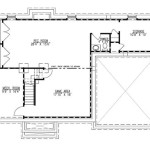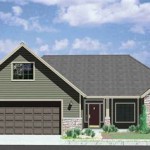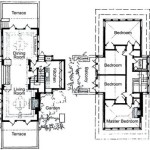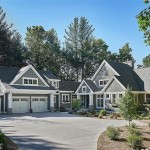Exploring the Versatility of 5-Bedroom Home Floor Plans
The decision to build or buy a home is a significant one, often driven by current needs and future aspirations. A five-bedroom home provides a substantial amount of living space, catering to larger families, multi-generational households, or those who desire ample space for hobbies, home offices, or guest accommodations. The appeal of a five-bedroom layout extends beyond simply increased square footage; it's about optimizing functionality, comfort, and the overall lifestyle the home fosters. This article delves into the diverse aspects of five-bedroom home floor plans, examining common layouts, design considerations, and the factors to consider during the planning process.
Five-bedroom homes offer flexibility in their design, ranging from traditional two-story structures to sprawling ranch-style residences. The internal configuration can be equally varied, with options for open-concept living spaces, dedicated formal areas, or a combination of both. Understanding the nuances of these floor plans is crucial for making an informed decision that aligns with individual preferences and lifestyle requirements.
Understanding Common 5-Bedroom Floor Plan Configurations
Several common configurations exist within the realm of five-bedroom home floor plans. These layouts often dictate the flow of the home, the placement of key rooms, and the overall feeling of spaciousness. Familiarity with these configurations provides a solid foundation for evaluating different plans and adapting them to specific needs.
One prevalent layout is the two-story design, where the main living areas, such as the kitchen, living room, and dining room, are typically situated on the ground floor. The upper floor usually houses the bedrooms, providing separation between living and sleeping spaces. This configuration is particularly popular due to its efficient use of space, allowing for a considerable amount of square footage without a large footprint. Within this two-story design, variations exist in the placement of the master suite. Some floor plans feature a master suite on the ground floor for added privacy and accessibility, while others locate it on the upper floor alongside the remaining bedrooms.
Another common configuration is the ranch-style or single-story layout. In this design, all living areas and bedrooms are situated on the same level. This configuration is particularly appealing to individuals with mobility concerns or those who prefer the convenience of a single-level living space. Ranch-style homes often feature a more open floor plan, promoting a seamless flow between rooms. However, they typically require a larger lot size compared to two-story homes.
Split-level homes represent another variation, characterized by staggered levels that separate different areas of the house. This design can offer a unique architectural aesthetic and functional separation between living spaces. In a five-bedroom split-level layout, the bedrooms might be located on one level, while the living areas are situated on a different level, providing a degree of privacy and noise reduction.
Beyond these core configurations, numerous hybrid designs exist, blending elements from different styles to create customized living spaces. Understanding the fundamental characteristics of each configuration allows for a more informed assessment of how a particular floor plan will function in practice.
Key Considerations in Designing a 5-Bedroom Home
Designing a five-bedroom home involves careful consideration of numerous factors beyond simply the number of bedrooms. These factors encompass practical aspects like room size and layout, as well as lifestyle considerations like traffic flow and noise isolation. Addressing these considerations early in the design process can significantly impact the overall livability and functionality of the home.
Room sizes are paramount in creating a comfortable and functional living space. While five bedrooms may seem ample, ensuring each bedroom is adequately sized for its intended purpose is crucial. A master suite should ideally be larger than the other bedrooms, providing space for a king-size bed, seating area, and potentially a walk-in closet. Secondary bedrooms should be large enough to comfortably accommodate a bed, desk, and storage. Careful attention should be paid to closet space in each bedroom to ensure sufficient storage for clothing and personal belongings.
The layout of the bedrooms in relation to each other and to other areas of the home is another critical consideration. For example, locating the master suite at the opposite end of the house from the other bedrooms can enhance privacy. Similarly, placing bedrooms near bathrooms and laundry areas can improve convenience. Traffic flow within the home should be carefully planned to minimize congestion and ensure easy access to all areas.
Noise isolation is particularly important in a multi-bedroom home, especially if it houses multiple occupants with different schedules. Utilizing soundproofing materials in walls and floors can help reduce noise transmission between rooms. Consider the placement of bedrooms in relation to noisy areas like the kitchen, living room, or home theater to minimize disturbances. The location of mechanical systems, such as the furnace and air conditioner, should also be considered to minimize noise pollution.
Natural light plays a significant role in the overall ambiance of a home. Maximizing natural light through strategically placed windows and skylights can create a brighter and more inviting living space. Consider the orientation of the home in relation to the sun when planning window placement to optimize solar gain in the winter and minimize heat buildup in the summer.
Finally, accessibility should be a key consideration, especially for multi-generational households or individuals with mobility concerns. Incorporating features like wider doorways, ramps, and grab bars can make the home more accessible to individuals of all ages and abilities. Even if accessibility is not a current concern, planning for future needs can add value and versatility to the home.
Adapting 5-Bedroom Floor Plans to Suit Different Lifestyles
The versatility of a five-bedroom home lies in its ability to adapt to various lifestyles and evolving needs. While the initial design may cater to a specific set of circumstances, the inherent flexibility of the space allows for repurposing and adaptation over time. Understanding the potential for customization is essential for maximizing the long-term value and utility of the home.
For families with young children, one or more of the bedrooms can be designated as playrooms or nurseries. These spaces can be designed with durable materials and child-friendly features to create a safe and stimulating environment. As children grow older, these rooms can be easily converted into bedrooms or study areas.
For individuals who work from home, one of the bedrooms can be transformed into a dedicated home office. This allows for a separate workspace that is free from distractions and conducive to productivity. A well-designed home office should include ample desk space, storage, and adequate lighting to ensure a comfortable and efficient work environment.
Guest accommodations are another common use for extra bedrooms. Creating a welcoming and comfortable guest room can provide a dedicated space for visiting friends and family, ensuring their privacy and comfort during their stay. A guest room should include a comfortable bed, storage space, and access to a bathroom.
Hobby rooms or studios are another popular application for spare bedrooms. Whether it's a painting studio, music room, or crafting space, a dedicated hobby room provides a place to pursue creative passions without disrupting the rest of the household. These spaces can be customized with specialized equipment and storage to suit the specific hobby.
Multi-generational households can particularly benefit from a five-bedroom home, as it allows for separate living spaces for different family members. One bedroom can be designated as an in-law suite, providing a private living space for elderly parents or other relatives. This can include a separate bathroom, kitchenette, and living area to ensure their comfort and independence.
Ultimately, the key to adapting a five-bedroom floor plan to suit different lifestyles lies in thoughtful planning and a willingness to repurpose spaces as needs evolve. The inherent flexibility of the layout allows for a wide range of possibilities, ensuring that the home remains a functional and comfortable living space for years to come.

One Story Five Bedroom Home Plans Homepw72132 4 457 Square Feet 5 3 B House 6

5 Bedroom House Plans Monster

5 Bedroom House Plans Perth Home Designs 2024

Buy V 384 House Floor Plans 5 Bedroom With Bathroom And 2 Car In Two Story Design

Beautiful House Plan With Five Bedrooms

Room To Grow 5 Bedroom House Plans Houseplans Blog Com

Exclusive 5 Bedroom Home Plan With Formal Dining And Keeping Rooms 510207wdy Architectural Designs House Plans

Manchester Homes The Paddington 5 Bedroom Floor Plan Modular Home Plans Luxury House Custom

5 Bedroom Open Concept House Plans Blog Eplans Com

5 Bedroom Apartment Plan Examples








